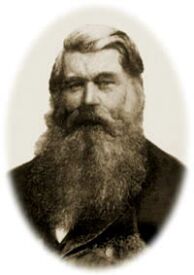- Joseph Swan
Infobox Scientist
name = Joseph Wilson Swan
box_width =
image_size =200px
caption =Photograph of Swan, c.1900
birth_date = Birth date|1828|10|31
birth_place =Bishopwearmouth ,England
death_date = Death date and age|1914|5|27|1828|10|31
death_place =Warlingham ,England
residence =
citizenship =
nationality = English
ethnicity =
field =physics chemistry
work_institutions =
alma_mater =
doctoral_advisor =
doctoral_students =
known_for =incandescent light bulb
author_abbrev_bot =
author_abbrev_zoo =
influences =
influenced =
prizes =
religion =
footnotes =Sir Joseph Wilson Swan (
October 31 ,1828 –May 27 ,1914 ) was an Englishphysicist andchemist , most famous for the invention of theincandescent light bulb .Early life
Swan was born in 1828 at Pallion Hall in
Bishopwearmouth (nowSunderland ), and he served an apprenticeship with apharmacist there. He later became a partner in Mawson's, a firm of manufacturing chemists inNewcastle upon Tyne . This company existed as "Mawson, Swan and Morgan" until 1973, formerly located on Grey Street in Newcastle-upon-Tyne nearGrey's Monument . The premises are now owned byWaterstones and can be identified by a line of Victorian-style electric street lamps in front of the store on Grey Street.Electric light
In 1850 he began working on a light bulb using carbonized paper filaments in an evacuated glass bulb. By 1860 he was able to demonstrate a working device, and obtained a UK patent covering a partial
vacuum , carbon filament incandescent lamp. However, the lack of a good vacuum and an adequate electric source resulted in an inefficient bulb with a small, uncontinued lifetime.Fifteen years later, in 1875, Swan returned to consider the problem of the light bulb with the aid of a better vacuum and a carbonised thread as a filament. The most significant feature of Swan's improved lamp was that there was little residual
oxygen in thevacuum tube to ignite the filament, thus allowing the filament to glow almost white-hot without catching fire. However, his filament had low resistance, thus needing heavy copper wires to supply it. [ [http://americanhistory.si.edu/lighting/bios/swan.htm Lamp Inventors 1880-1940: Carbon Filament Incandescent] ]Edison collaboration
Swan received a British patent for his device in 1878, about a year before
Thomas Edison . Swan had reported success to the Newcastle Chemical Society and at a lecture inNewcastle upon Tyne in February 1879 he demonstrated a working lamp. Starting that year he began installing light bulbs in homes and landmarks in England. His house Underhill on Kells Lane inLow Fell ,Gateshead was the first in the world to have working light bulbs installed. In 1881 he had started his own company, The Swan Electric Light Company, and started commercial production.In America Edison had been working on copies of the original Swan patent, trying to make them more efficient. Though Swan had beaten him to this goal, Edison obtained patents in America for a fairly direct copy of the Swan light, and started an advertising campaign which claimed that he was the real inventorFact|date=February 2008. Swan, who was less interested in making money from the invention, agreed that Edison could sell the lights in America while he retained the rights in BritainFact|date=February 2008.
Ediswan
In 1883 the
Edison & Swan United Electric Light Company was established. Known commonly as "Ediswan" the company sold lamps made with a cellulose filament that Swan had invented in 1881. Variations of thecellulose filament became an industry standard, except with the Edison Company. Edison continued usingbamboo filaments until the 1892 merger that createdGeneral Electric , and that company then shifted to cellulose.In 1886 [Pam, D. (1977),"The New Enfield: Stories of Enfield Edmonton and Southgate, a Jubilee History", London Borough of Enfield Libraries, Arts & Entertainment Dept] Ediswan moved production to a former
jute mill atPonders End , north London. In 1916 Ediswan set up Britain's first radiothermionic valve factory at Ponders End. This area, with nearby Brimsdown subsequently developed as a centre for the manufacture of valves,cathode ray tube s etc and nearby parts ofEnfield became an important centre of theelectronics industry for much of the 20th century. Ediswan became part ofBritish Thomson-Houston and AEI in the late 1920s. [Lewis J.(2001), "London's Lea Valley: More Secrets Revealed", Phillimore, ISBN 1-86077-190-4]Photography
When working with wet photographic plates, Swan noticed that heat increased the sensitivity of the silver bromide emulsion. By 1871 he had devised a method of drying the wet plates, initiating the age of convenience in photography. Eight years later he patented
bromide paper , developments of which are still used for black and white photographic prints.Three years later, while searching for a better carbon filament for his light bulb, Swan patented a process for squeezing nitro-cellulose through holes to form fibres. The textile industry has used his process.Fact|date=September 2008
Swan was knighted in 1904. He died in 1914 at
Warlingham inSurrey .References
External links
* [http://www.tyneandweararchives.org.uk Tyne & Wear Archives Service] Joseph Swan collection
Wikimedia Foundation. 2010.
